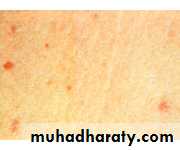TYPHOID AND PARATYPHOID (ENTERIC) FEVERS
For Fourth- Year Medical StudentsDr: Hussein Mohammed Jumaah
CABM
Mosul College of Medicine
9/12/2014
The name typhoid is from Greek words which mean similar to typhus. The word typhus, signifying stupor, stupid, dull or low.
Salmonellae
Gram-negative bacilli.
Motile ,facultatively anaerobic, do not
form spores.The Genus Salmonella
belong to Enterobactericiae .
The infectious dose varies from 103 to 106 colony-forming units.
The growth of serotypes S. Typhi and S. Paratyphi (serotypes A, B, and C) is restricted to human hosts and causes typhoid and paratyphoid (enteric) fevers
The remaining serotypes
(nontyphoidal Salmonella, NTS) can colonize the gastrointestinal tracts of a broad range of animals, including mammals, reptiles, birds, and insects.
More than 200 serotypes are pathogenic to humans, in whom they often cause gastroenteritis.
Salmonellosis
Pathology
Infections begin with ingestion of organisms. After a few days of bacteraemia, the bacilli localise mainly in the lymphoid tissue of the small intestine, the Peyer's patches and follicles.These swell at first, then ulcerate and ultimately heal, but during this sequence they may perforate or bleed.
Typhoid and paratyphoid (enteric) fevers
Transmitted by the faecal–oral route.After a few days of bacteraemia, the bacilli localise, mainly in the lymphoid tissue of the small intestine, resulting in typical lesions in the Peyer’s patches and follicles. These swell at first, then ulcerate and usually heal.
After clinical recovery, about 5% of patients become chronic carriers (i.e. continue to excrete the bacteria after 1 year); the bacilli may live in the gallbladder for months or years and pass intermittently in the stool and, less commonly, in the urine.
Clinical features
Typhoid feverThe incubation period is typically about 10–14 days and the onset may be insidious. The temperature rises in a stepladder fashion for 4 or 5 days with malaise, increasing headache, drowsiness and aching in the limbs. Constipation may be caused by swelling of lymphoid
tissue around the ileocaecal junction, although in
children diarrhoea and vomiting may be prominent early in the illness. The pulse is often slower than would be expected from the height of the temperature, i.e. a relative bradycardia.
At the end of the first week, a rash may appear on the upper abdomen and on the back as sparse, slightly raised, rose-red spots, which fade on pressure. It is usually visible only on white skin.
Cough and epistaxis occur.
Around the 7th–10th day, the spleen becomes palpable. Constipation is then succeeded by diarrhoea and abdominal distension with tenderness.
Bronchitis and delirium may develop.
If untreated, by the end of the second week the patient may be profoundly ill.
Investigations
In the first week, diagnosis may be difficult because, in this invasive stage with bacteraemia, the symptoms are those of a generalised infection without localising features.A white blood count may be helpful, as there is typically a leucopenia.
Blood culture is the most important diagnostic method.
The faeces contain the organism more frequently in the second and third weeks.
The Widal reaction is not reliable.
ManagementAntibiotic therapy must be guided by in vitro sensitivity testing. Chloramphenicol (500 mg 4 times daily), ampicillin (750 mg 4 times daily) and co-trimoxazole (2 tablets or IV equivalent twice daily) are losing their effect due to resistance in many areas of the world.
The fluoroquinolones are the drugs of choice (e.g. ciprofloxacin 500 mg twice daily) if the organism is susceptible, but resistance is common.
Extended-spectrum cephalosporins (ceftriaxone and cefotaxime) are useful alternatives but have a slightly increased treatment failure rate.
Azithromycin (500 mg once daily) is an alternative when fluoroquinolone resistance is present but has not been validated in severe disease.
Treatment should be continued for 14 days.
Pyrexia may persist for up to 5 days after the start of
specific therapy.
Even with effective chemotherapy,
there is still a danger of complications, recrudescence of
the disease and the development of a carrier state.
Chronic carriers (1–5%) were formerly treated for 4 weeks with ciprofloxacin but may require an alternative agent and duration, as guided by antimicrobial sensitivity testing. Cholecystectomy may be necessary.
Complications
Haemorrhage from, or a perforation of, the ulcerated Peyer’s patches may occur at the end of the second or during the third week of the illness.A drop in temperature to normal or subnormal levels may be falsely reassuring in patients with intestinal haemorrhage.
Additional complications may involve almost any viscus or system because of the septicaemia present during the first week.
Bone and joint infection is common in children with sickle-cell disease.
Relapse
Despite prompt treatment & apparent recovery relapse rates remain at 10% in immunocompetent hosts, typically occur approximately 1 week after therapy is discontinued. After discharge, patients should be monitored for relapse or complications for 3 months after treatment. A relapse is generally milder and of shorter duration.In rare cases, second or even third relapses occur.
Notably, the relapse rate is much lower following treatment with the new quinolone, which have effective intracellular penetration.
Previous infection does not confer immunity.
Prevention
Improved sanitation and living conditions reduce the incidence of typhoid.Travellers to countries where enteric infections are endemic should be inoculated with one of the three available typhoid vaccines
(two inactivated injectable and one oral live attenuated).
Simple hand hygiene and washing can reduce cases of Typhoid
Paratyphoid fever
• The course tends to be shorter and milder than that of typhoid fever• The onset is often more abrupt with acute enteritis.
• The rash may be more abundant
• Intestinal complications less frequent.
• Vaccines are not effective in prevention of Paratyphoid fevers.











